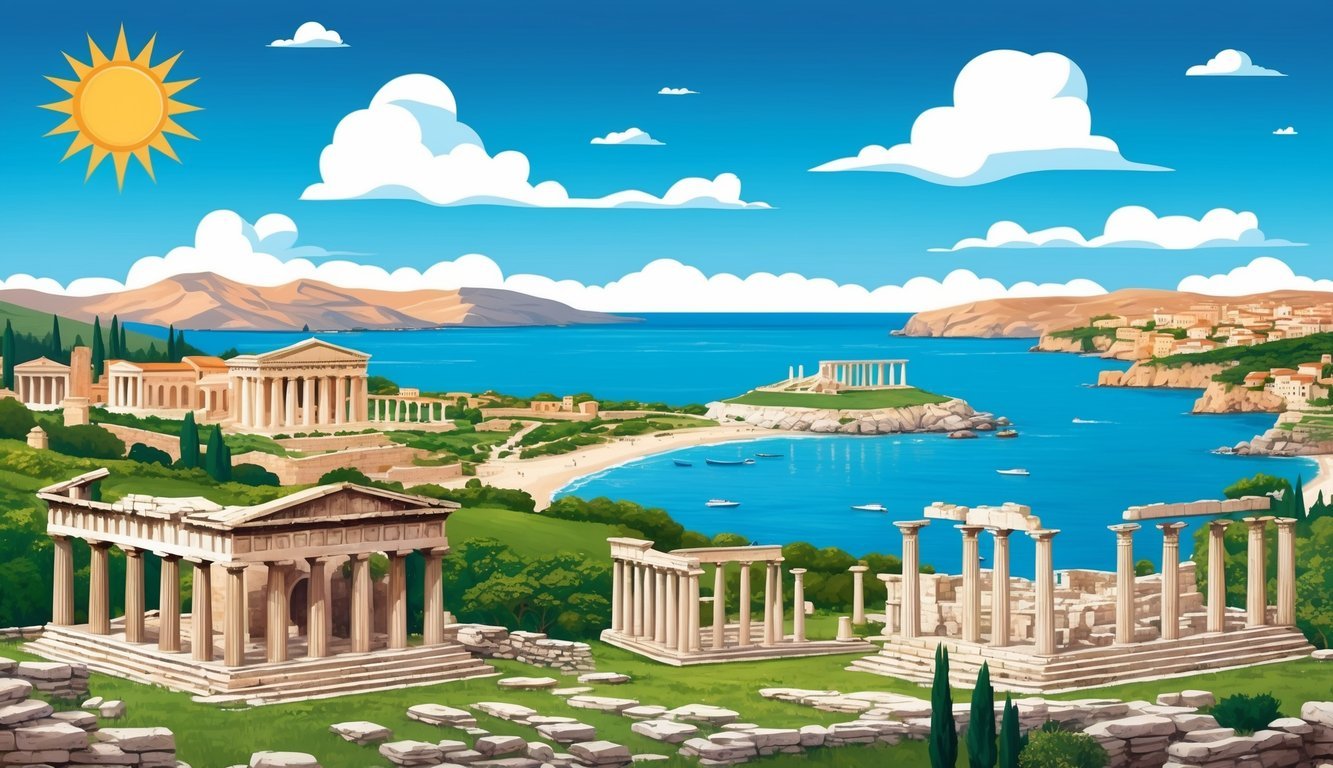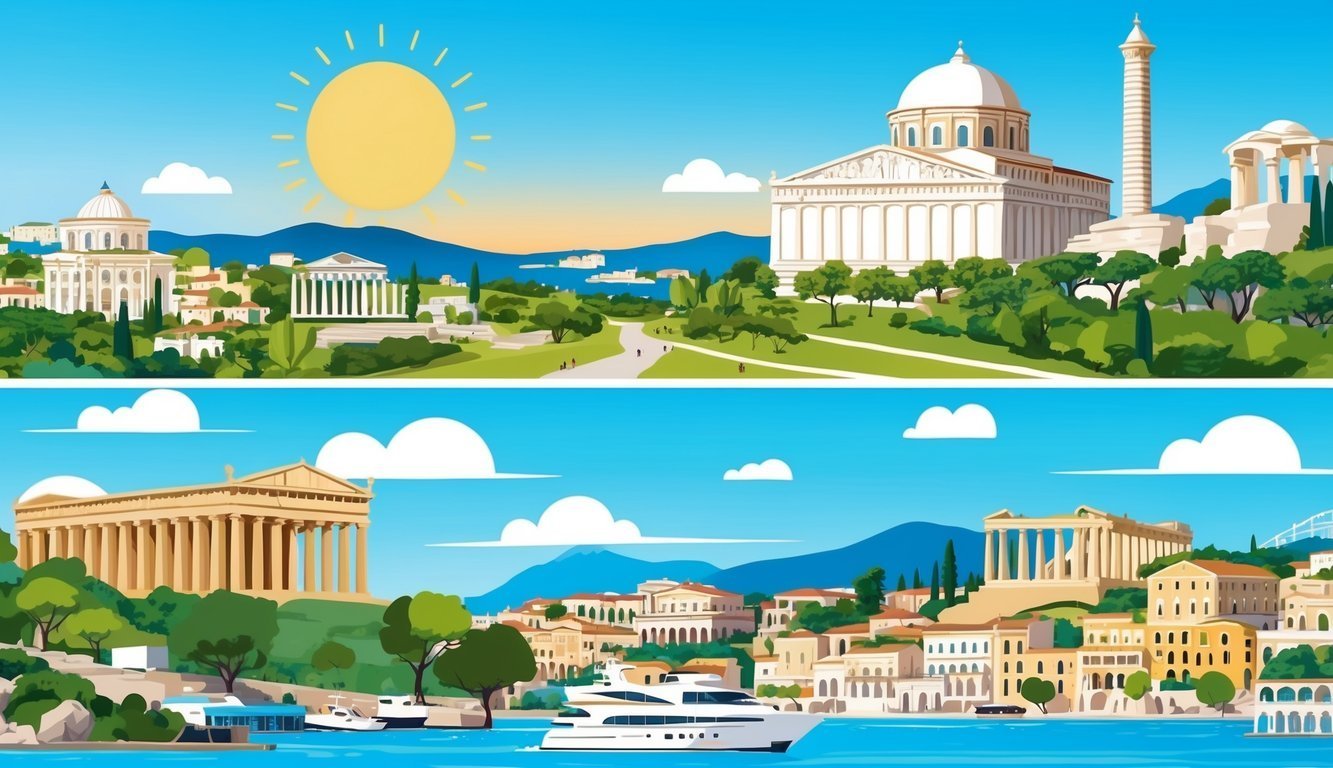If you’re planning a trip to Italy and Greece, timing can make all the difference in your experience.
The best times to visit these beautiful countries maximize your enjoyment of pleasant weather, charming landscapes, and fewer crowds.
Understanding when to go can help you explore historic sites, relax on stunning beaches, and savor the local cuisine without the hustle and bustle of peak tourist seasons.
From the lively streets of Rome to the serene shores of Santorini, each season offers something unique.
You’ll want to consider what activities you most enjoy and how weather conditions can enhance your travel.
Whether you’re after vibrant festivals, beautiful scenery, or a peaceful getaway, knowing the ideal times for your visit is key to making the most of your trip.
Weather Insights

Understanding the weather is key for planning your trip to Italy and Greece.
Each country has unique seasonal variations that affect your travel experience.
Here’s a closer look at what to expect.
Seasonal Variations in Italy
In Italy, the weather changes significantly with the seasons.
-
Spring (March to May): Temperatures start to rise, ranging from 50°F to 70°F (10°C to 21°C). This is a lovely time for outdoor activities, with blooming flowers and mild days.
-
Summer (June to August): Expect hot, dry weather, especially in July and August. Average temperatures can reach 85°F (29°C) or higher. Coastal areas are great if you like beach fun.
-
Fall (September to November): Early fall offers pleasant temperatures, usually between 60°F to 75°F (15°C to 24°C). By November, it gets cooler with more rain, but fewer tourists.
-
Winter (December to February): Winters are mild in the south and colder in the north, with temperatures often dipping to 30°F (0°C). Snow can occur in northern regions, adding a charming winter atmosphere.
Greece’s Mediterranean Climate
Greece boasts a Mediterranean climate that is characterized by hot, dry summers and mild, wet winters.
-
Summer (June to August): Expect scorching temperatures, often reaching 90°F (32°C) or higher. The islands, like Mykonos and Santorini, become popular destinations for sun-seekers.
-
Fall (September to November): Early fall still offers warm temperatures, making it a great time for sightseeing without the summer crowds. By late October, expect some rain, especially in November.
-
Winter (December to February): Winters in Greece are generally mild, particularly in southern areas. Average temperatures range from 40°F to 60°F (4°C to 15°C). Rain is more common, but many find it a pleasant time to visit.
-
Spring (March to May): Spring brings mild weather and blooming landscapes, perfect for exploring. Temperatures can range from 50°F to 75°F (10°C to 24°C). Expect fewer tourists and beautiful sights.
Cultural Events and Festivals
Visiting Italy and Greece offers you a chance to dive into vibrant cultural events and festivals.
These celebrations reflect rich histories and local traditions, making your trip even more memorable.
Italian Festivals to Experience
Italy has a wide array of festivals to enjoy throughout the year.
One of the most famous is Venice Carnival, held in February.
You’ll see stunning masks and costumes, creating a magical atmosphere in the streets.
In August, the Palio di Siena is a thrilling horse race held in the city’s historic square.
It’s a fierce competition between different city neighborhoods, full of cheering crowds and colorful flags.
Don’t miss the Feast of San Gennaro in Naples, celebrated in September.
Enjoy street food, music, and processions, highlighting the city’s culinary and cultural delights.
Greek Traditions and Celebrations
Greece is known for its lively festivals that celebrate both religious and cultural heritage.
A highlight is Easter Sunday, when locals engage in family gatherings, outdoor feasts, and fireworks.
It’s a unique experience that shows the warmth of Greek culture.
The Athens Festival, held from June to September, showcases theater, music, and dance performances.
You can enjoy events in the ancient Herodes Atticus Theater with stunning views of the Acropolis.
Another significant celebration is the Apokries, or Greek Carnival, which takes place before Lent.
You’ll find parades, parties, and delicious food as people dress in costumes, making it a festive atmosphere.
Tourist Crowds and Off-Season Benefits
Visiting Italy and Greece during the off-season can be a game changer.
You’ll often find fewer crowds, allowing you to explore popular sights without feeling rushed.
In the spring (March to May) and early fall (September to October), both countries shine.
During these months, you enjoy pleasant weather and a more relaxed atmosphere.
The busy summer tourists are mostly gone, giving you more space to soak in the beauty.
Here are a few benefits of off-season travel:
- Lower Prices: Hotels and flights are often cheaper. This lets you stretch your travel budget.
- Shorter Lines: You’ll spend less time waiting in line at attractions. More time for fun!
- Authentic Experiences: With fewer tourists, you can engage more with locals. They may even share hidden gems you wouldn’t find otherwise.
You can plan your trip around events too.
For example, fall is a great time to experience local festivals, food fairs, and harvest activities.
If you’re looking for an adventure with fewer crowds and more charm, off-season travel is the way to go.
Italy and Greece in these months become your own special getaway!
Frequently Asked Questions
Traveling to Italy and Greece brings up many questions.
It’s great to know key details about the best times to visit, how long to stay, and what to include in your trip.
Here are some of the most common inquiries that travelers have.
What’s the best time of year to tour both Italy and Greece?
The best time to tour both countries is during the shoulder seasons, which are late spring (April to June) and early fall (September to October).
During these months, you can enjoy pleasant weather and fewer crowds, making your experience more enjoyable.
How long should a combined trip to Italy and Greece ideally last?
For a comfortable exploration of both countries, a trip lasting about 14 to 15 days is ideal.
This timeframe allows you to see major highlights without feeling rushed.
Which months are ideal for experiencing good weather in Italy and Greece?
May, early June, September, and October offer some of the best weather in both countries.
You can expect warm temperatures and minimal rain, perfect for sightseeing and outdoor activities.
What are the peak travel seasons for Italy and Greece?
The peak travel seasons are typically during the summer months of July and August.
During this time, crowds are larger and prices for accommodation and flights tend to be higher.
How can I plan an affordable vacation to Italy and Greece?
To plan an affordable trip, consider booking in advance and traveling during the shoulder seasons.
Look for budget airlines for flights between cities.
Additionally, use local transportation and enjoy affordable dining options to save money.
What should be included in a two-week itinerary for Italy and Greece?
A two-week itinerary can include major cities like Rome, Florence, Athens, and Santorini.
Focus on key attractions, local cuisine, and a mix of cultural experiences to make the most of your time in both countries.

